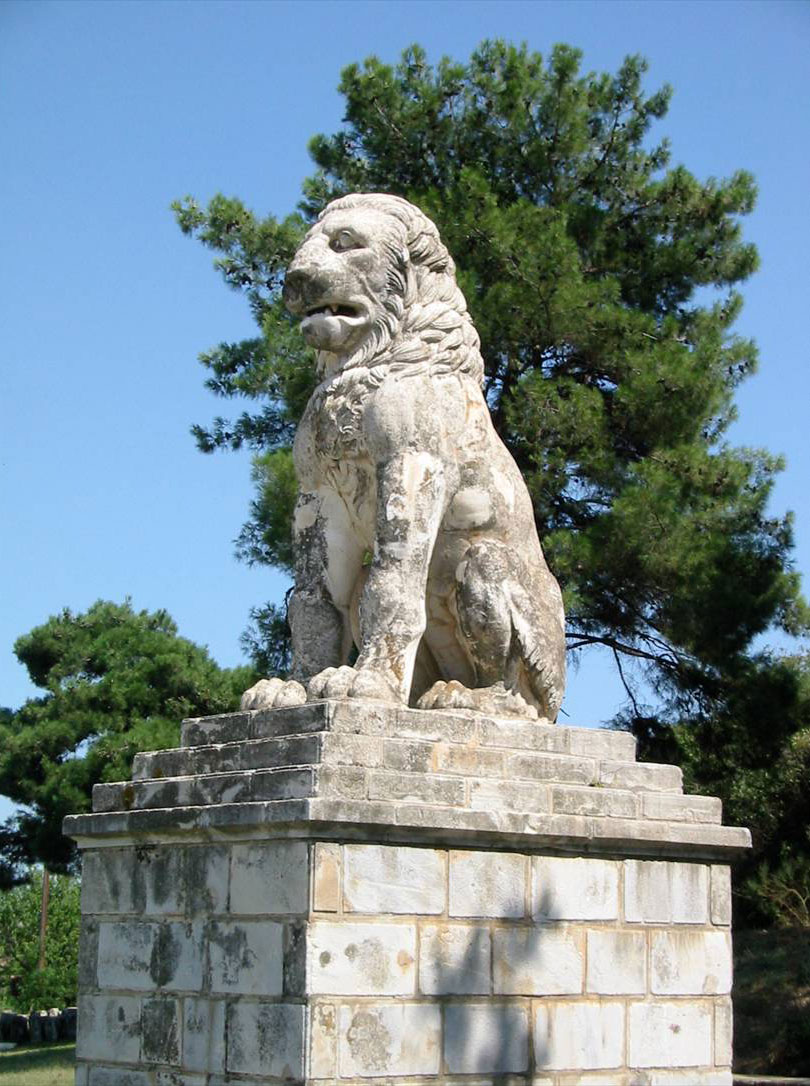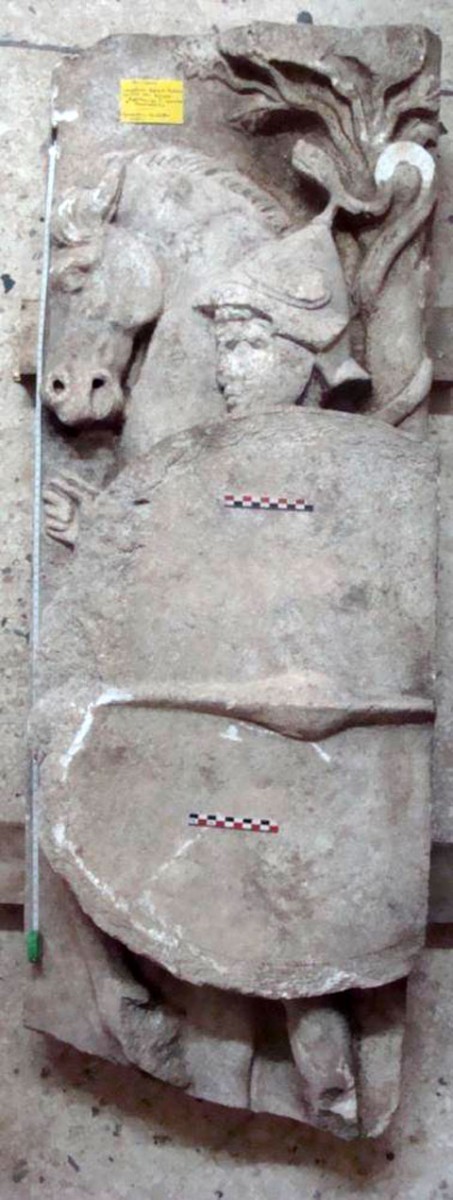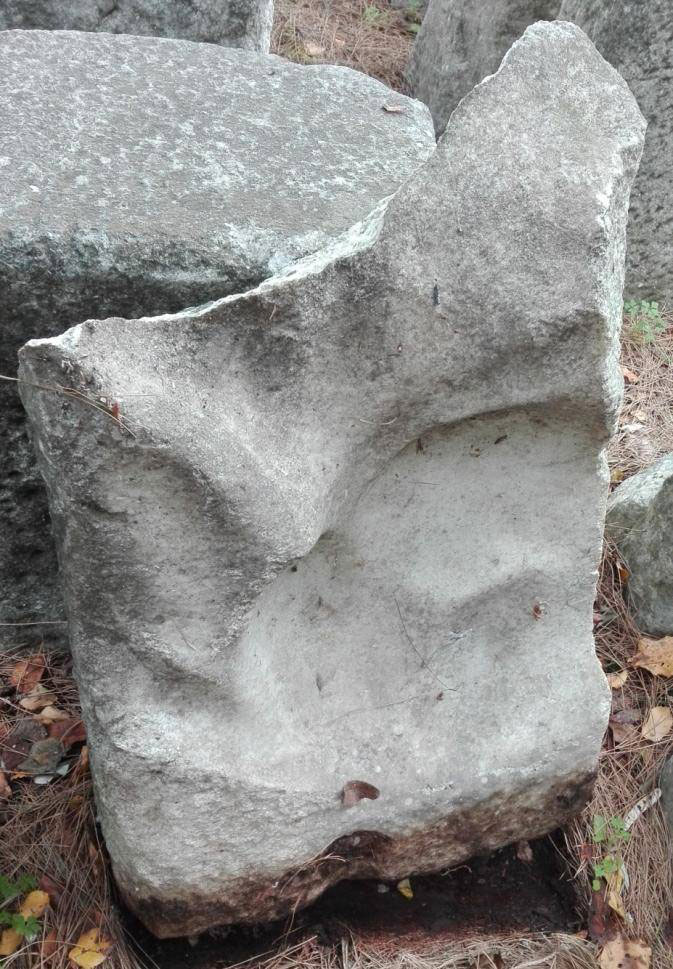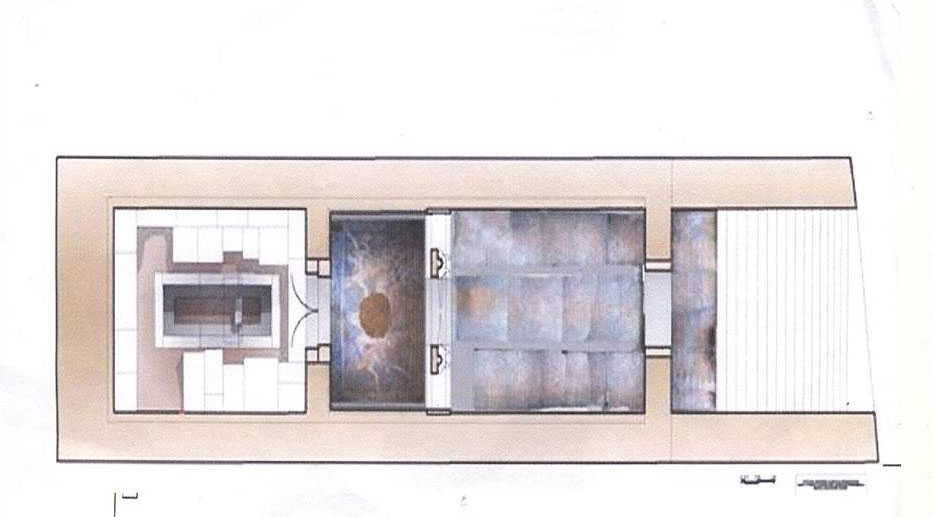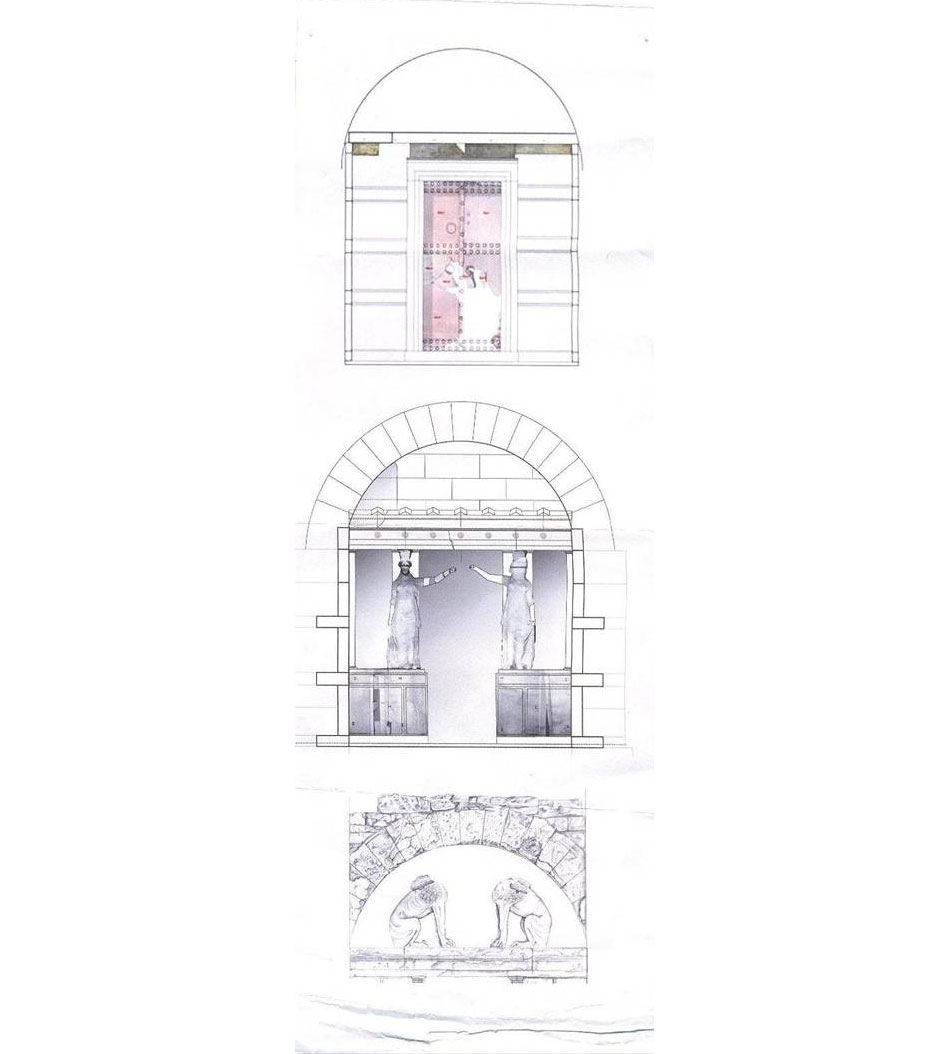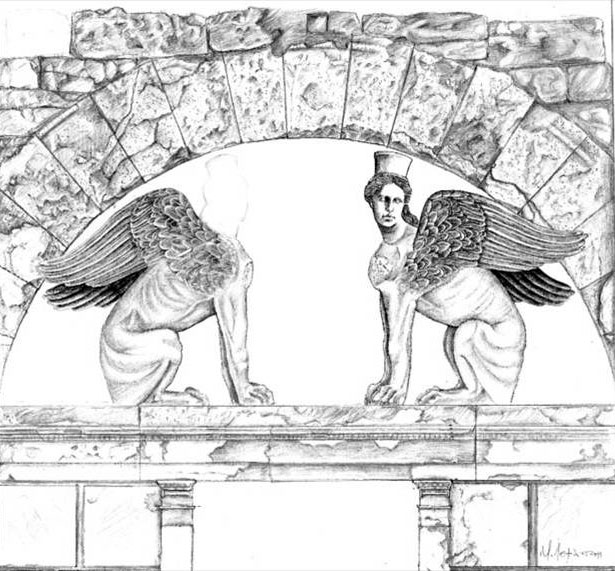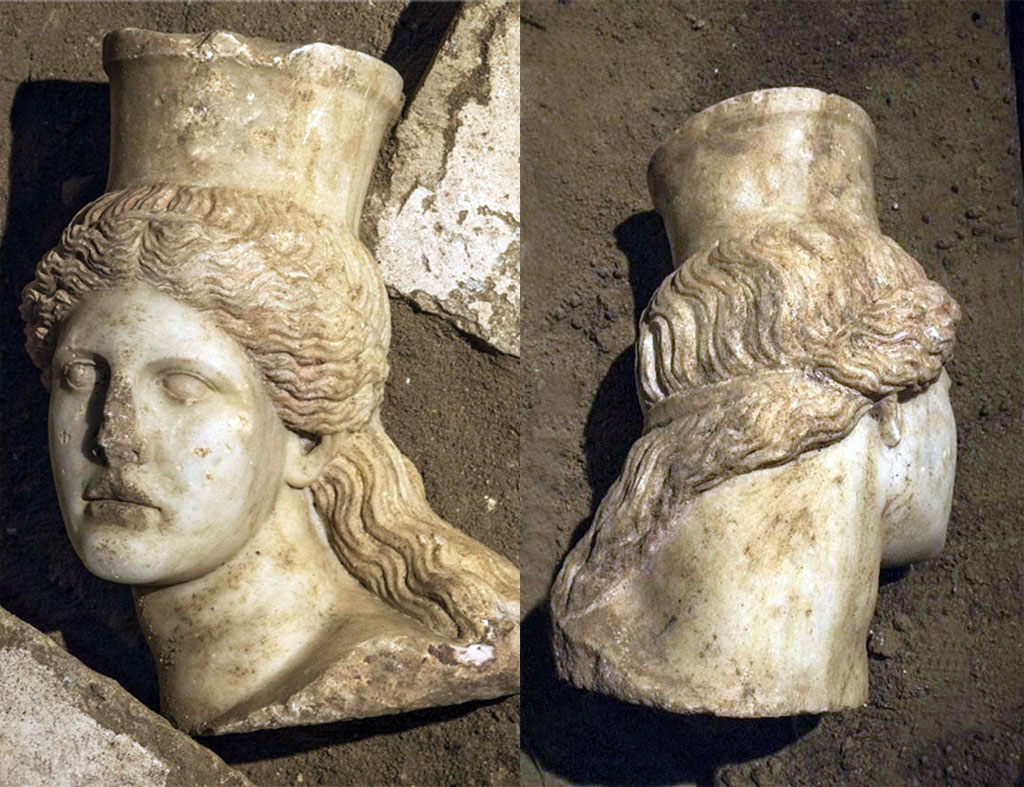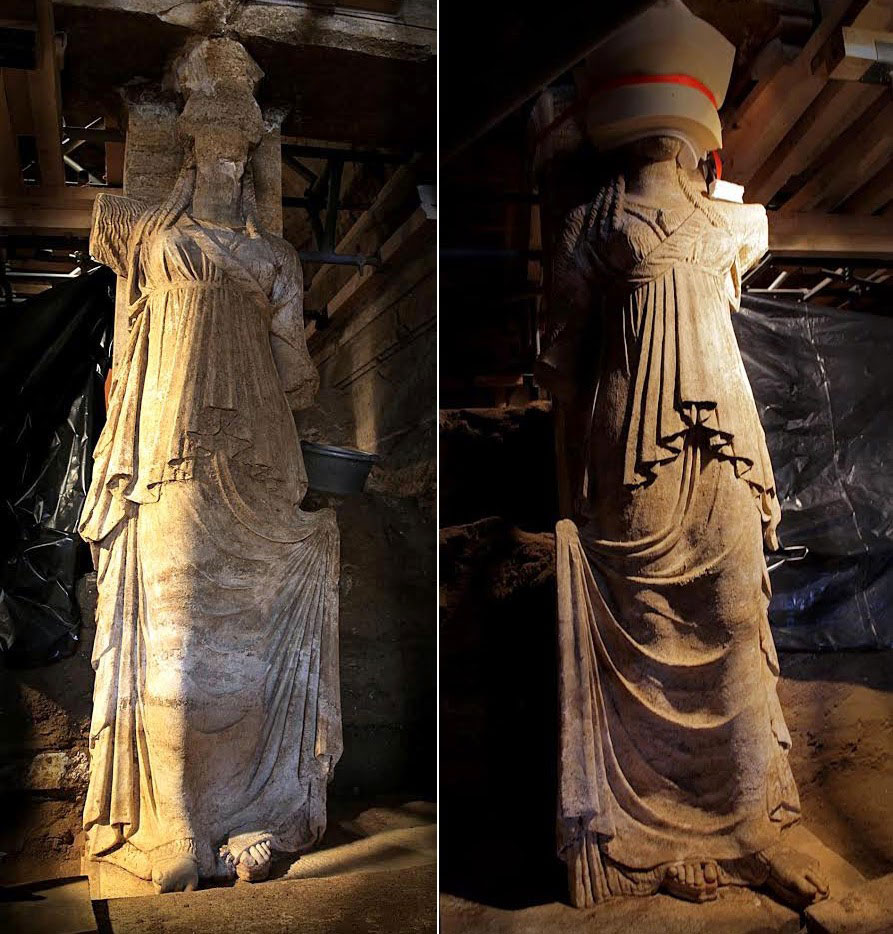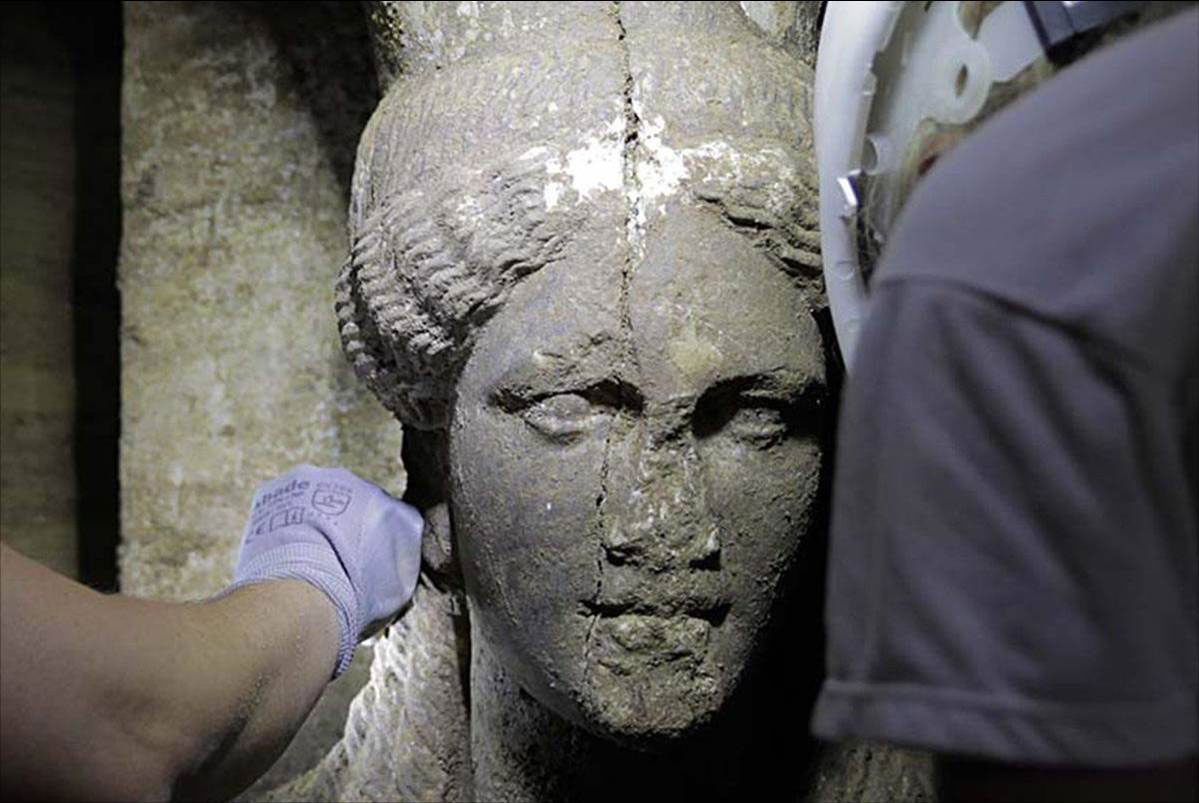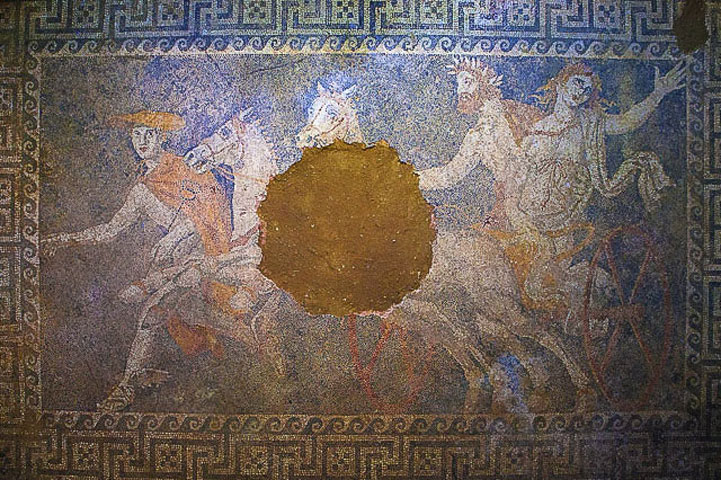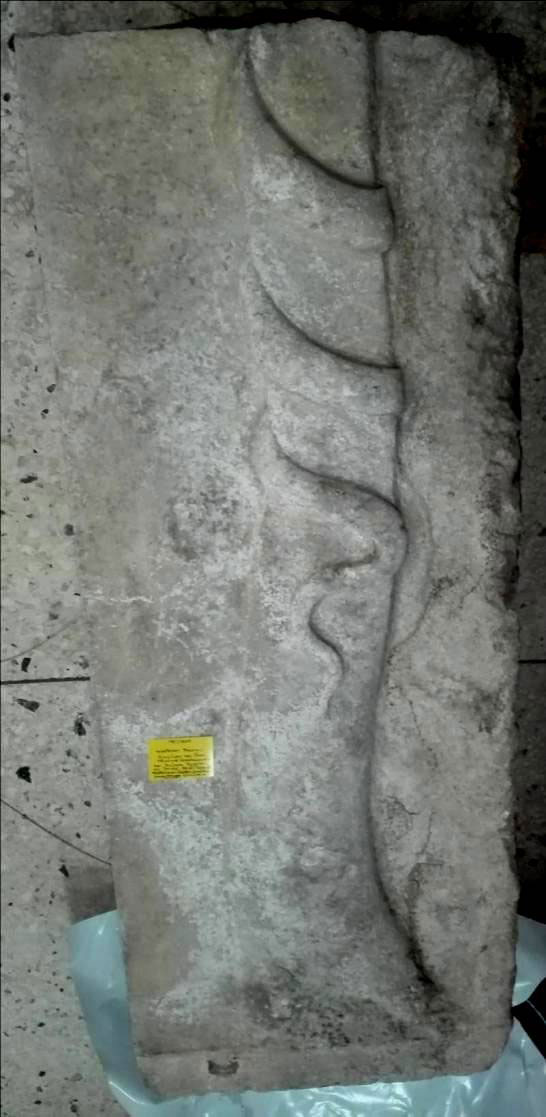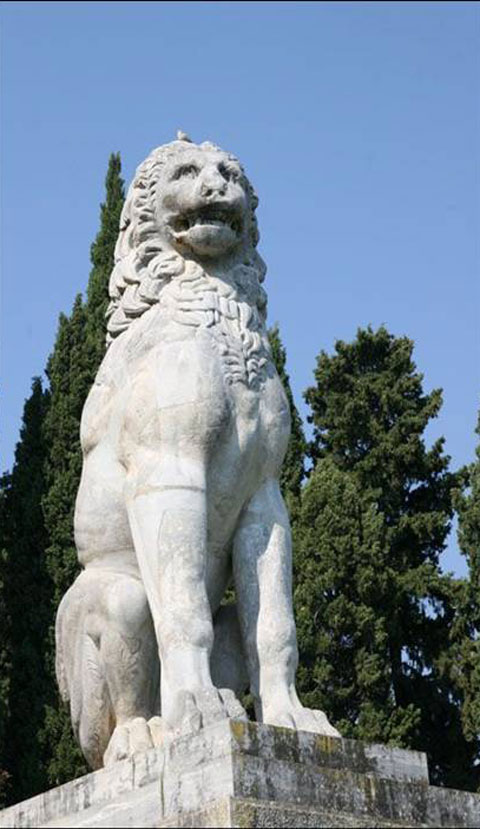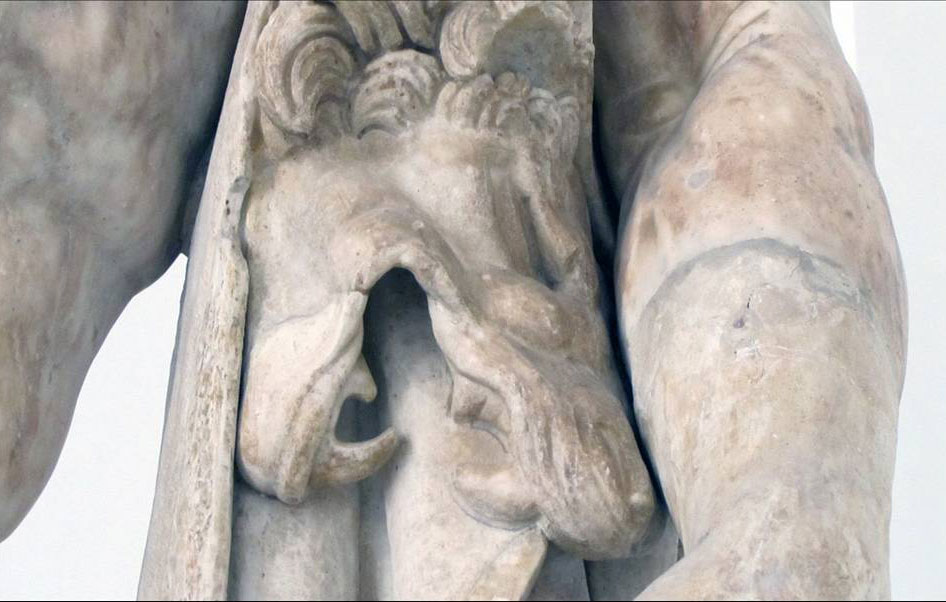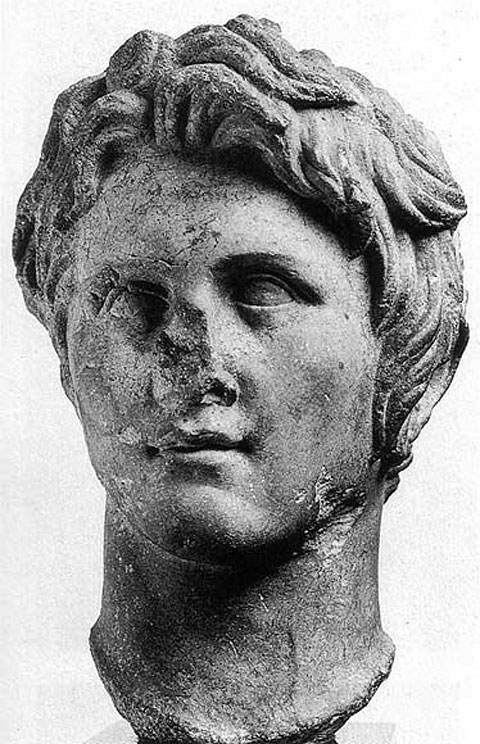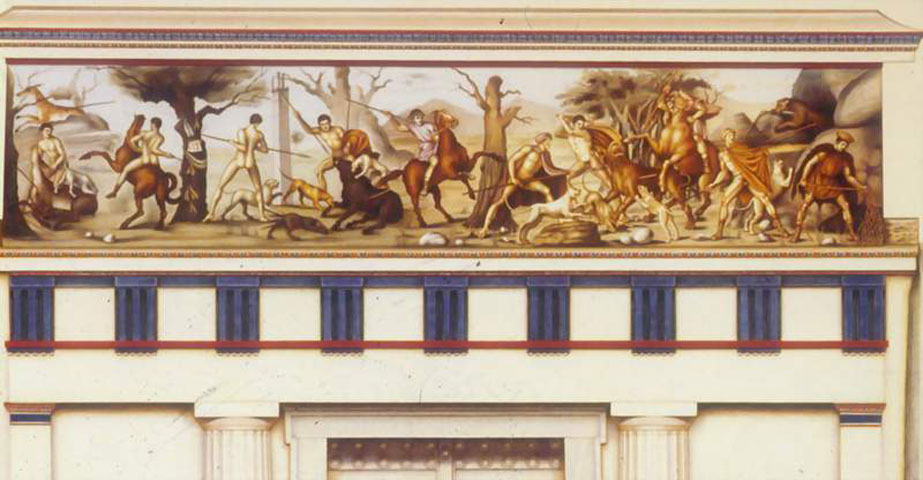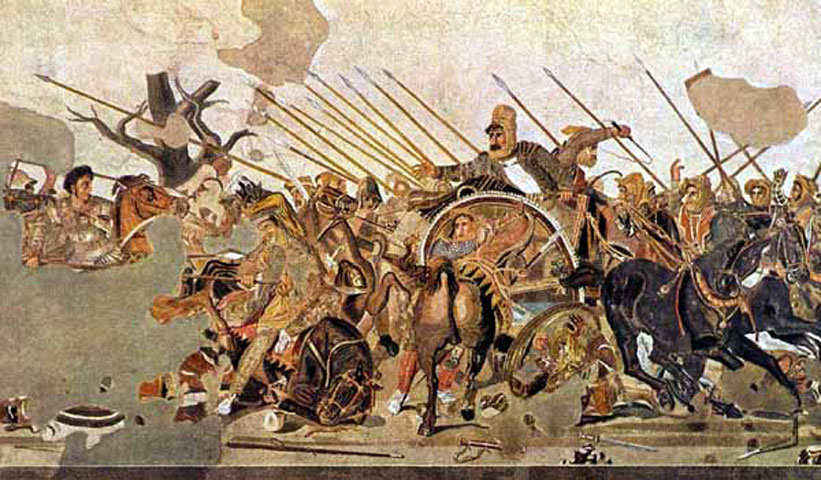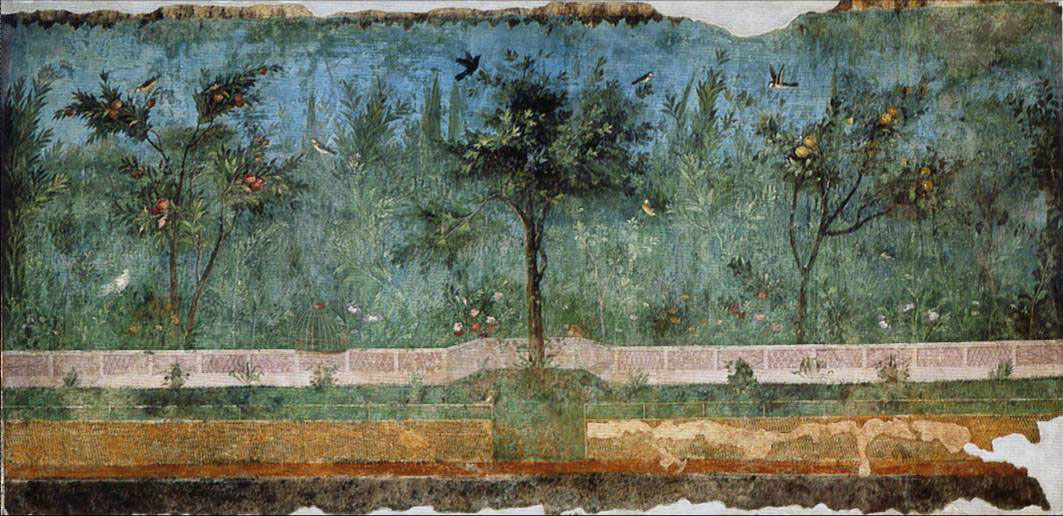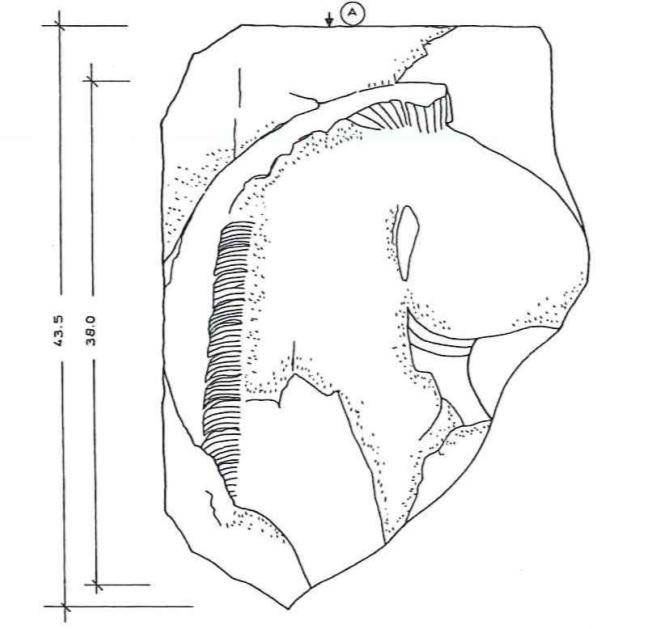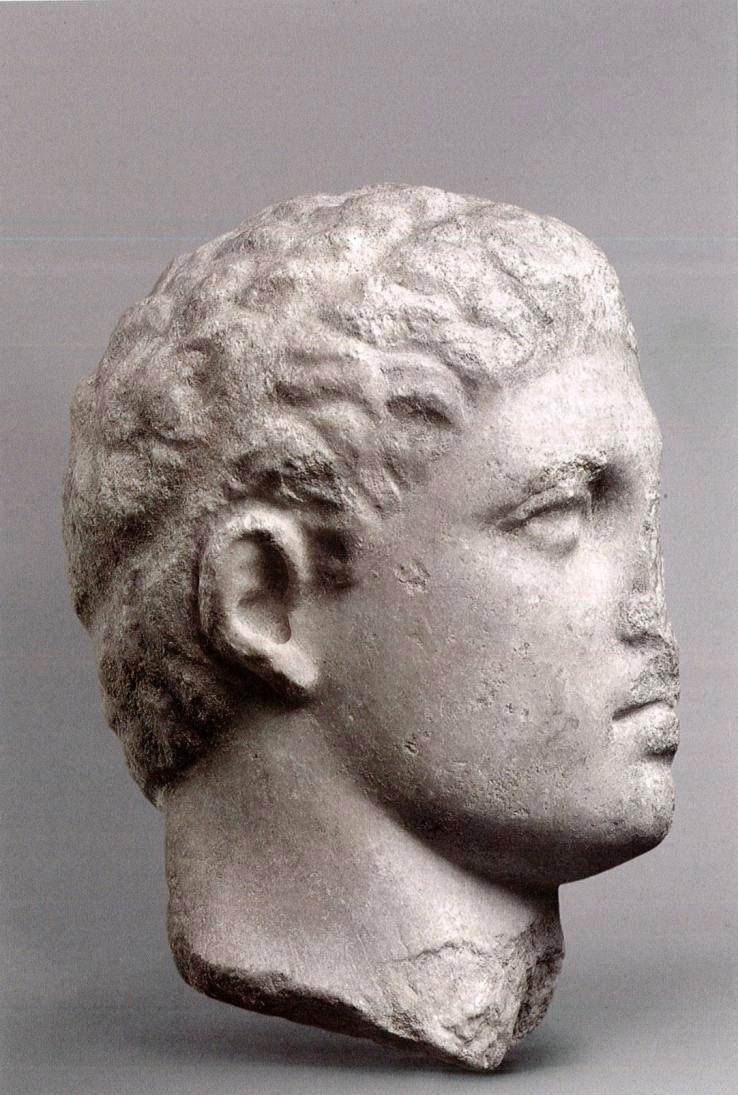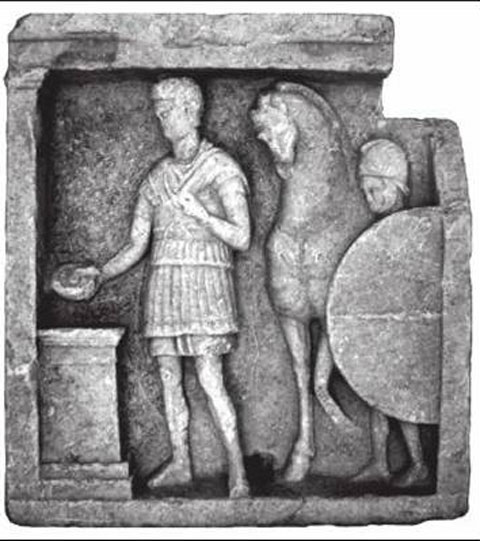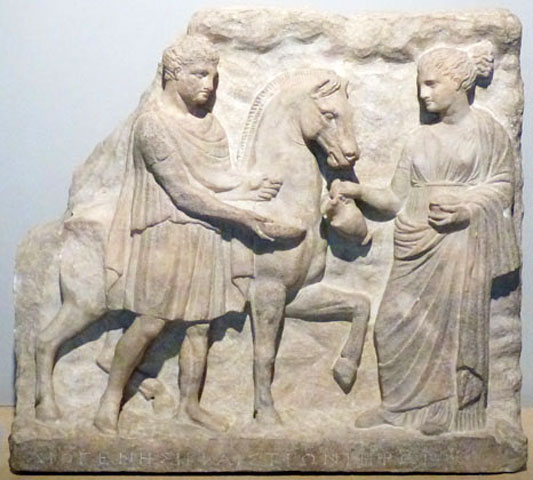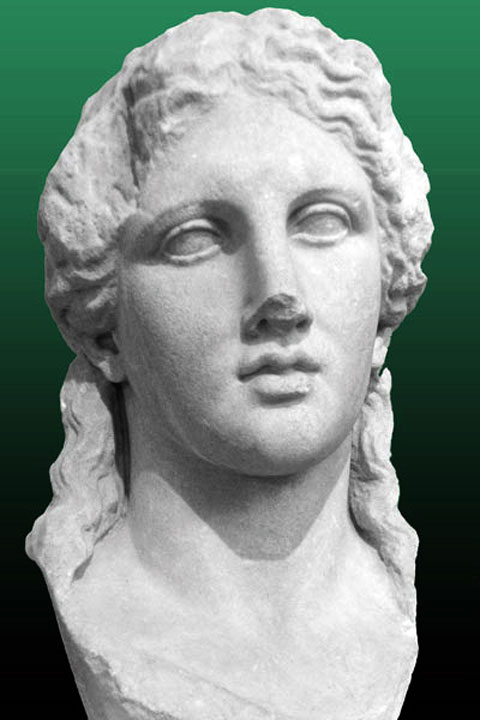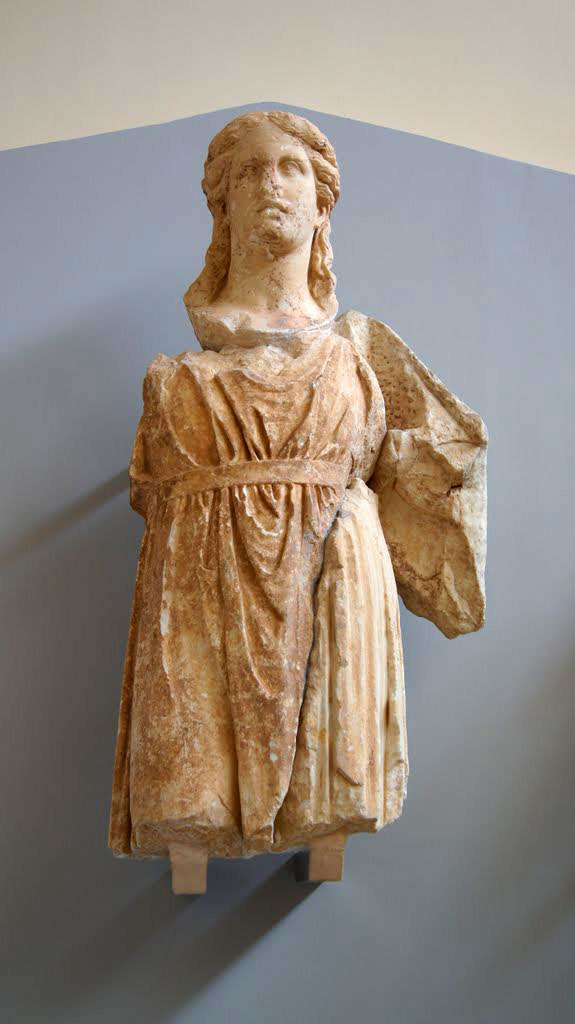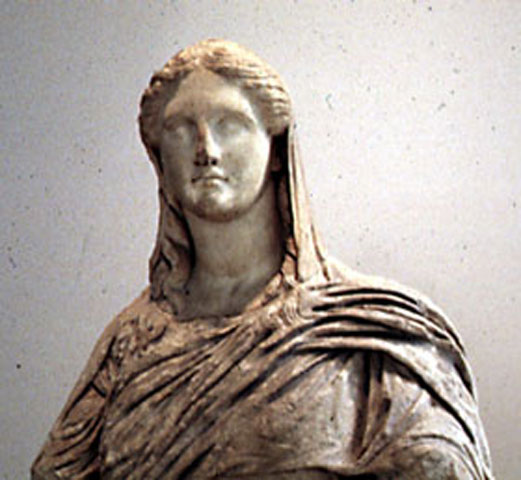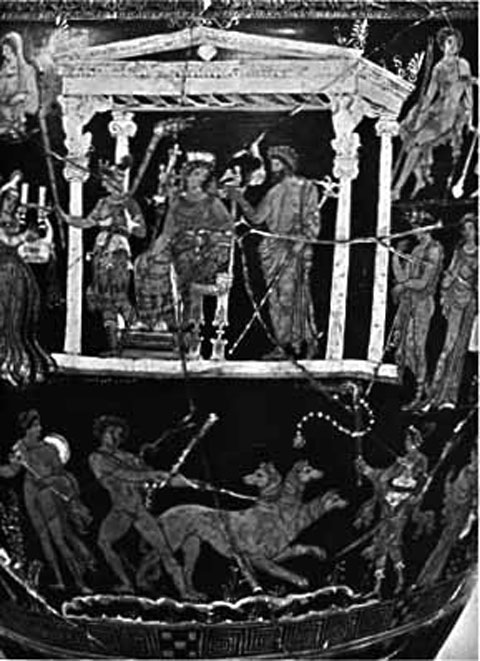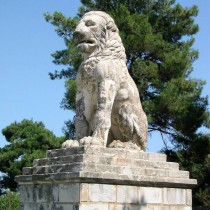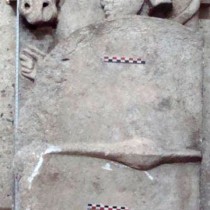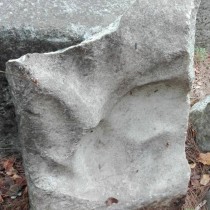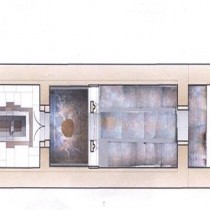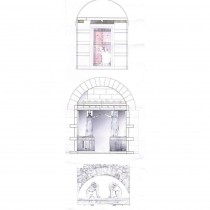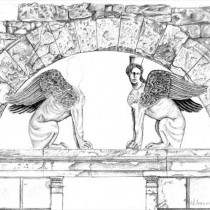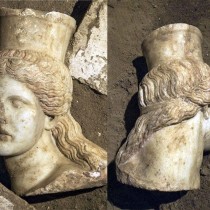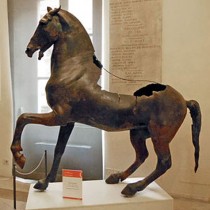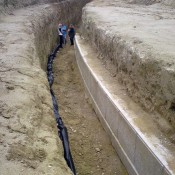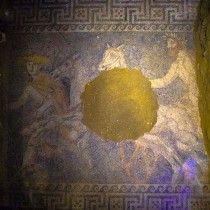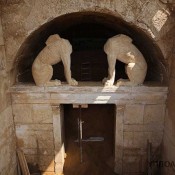a. General presentation of the monument
The tumulus Kasta is a very large monument near the ancient town of Amphipolis in northeastern Greece.
The region of Amphipolis was regarded part of Thrace until the Athenians colonized this region in 437 BC and especially until it was incorporated into the Kingdom of Macedon by Philip II in 357 BC. From that year this area shared the vicissitudes of the Macedonian state.
The tumulus has a circular base and a conic elevation. Its base is marked by a retaining wall of pseudo-isodomic masonry. Above this wall, the tumulus has the appearance of a natural hill. On top of the tumulus, there is a base for a huge monument: a large lion in Thasian marble which at a later time was moved a few kilometers to the south, near the river Strymon and the coast (fig. 1). The original presence of the lion on the summit of the tumulus is confirmed by the circumstance that a fragment of the lion, corresponding to its left shoulder, was discovered on the tumulus.
The base of the lion was endowed with a relief frieze of which two fragments survive: the first fragment depicts a warrior wearing a helmet and holding a Macedonian shield. His face looks like a portrait. Behind him, a fig tree is represented and a snake is coiling around the tree. The head of the snake is very close to the helmet of the warrior. Behind the young man, there is a horse (fig. 2).
In the second fragment, the hind legs of a rearing up horse are represented (fig. 3).
The tumulus has also a succession of rooms which lead to a burial chamber (fig. 4). From the external circuit the entrance to this sequence of rooms takes place through 15 descending steps. These steps occupy most of the first room. The floor of the remaining part of the room is a stone chips pavement decorated with geometric patterns.
Above the entrance to the second room (fig. 5), there is an Ionic architrave with three fasciae which supports two Sphinxes (fig. 6).
The state of preservation of the bodies of the Sphinxes is quite good, large fragments of their large wings have been found, the head of the Sphinx at the viewer’s right has been recovered (fig. 7) while the head of the other Sphinx is missing.
The second room is a long rectangle. Its ceiling is a barrel vault, while its pavement is a stone chips one but without geometric patterns. However, a rectangular area in the center of the room is framed by stone chips. This fact suggests that a base supporting a statuary monument was placed there.
Room no. 2 ends toward the internal part of the tumulus with two high bases without upper moldings, which support two pillars and, in front of these pillars, with two female architectural figures, called korai (popularly denominated Karyatids) (fig. 8). They were standing, looking straight ahead, with one foot slightly in front of the other. They wear chiton, himation, indented sandals, girdles below their breasts, their hands on the external sides are lowered and holding their draperies. Their inner arms are not preserved but the surviving fragment of a hand suggests that these arms were outstretched and held wreaths toward the person represented in the middle of the room.
On their heads the korai wear high poloi with which they support an Ionic architrave with three fasciae. Only one face of the two korai survives (fig. 9) and features the typical late classical anatomic grammar. The hair is divided in the middle and characterized by wavy locks.
Behind the korai there is a narrow third room which is adorned with a pebble mosaic floor representing the kidnapping of Kore (fig. 10) as well as with a painted upper cornice.
The third room leads through a typically Macedonian marble door to the fourth and last room: there the rests of the cremation of a young man have been found, the remains of a woman were thrown on this spot without an orderly re-composition of her body. The skeletal remains of two headless men who were 35 to 45 years old and of a child were also thrown on the spot.
Finally, a stele representing a fig tree with a snake coiling around the shaft of the tree, not corroded by weather conditions, must have been standing inside one of these four rooms: probably in the fourth room because only there the pavement allows the setting of this element (fig. 11).
b. The lion of Amphipolis
The lion of Amphipolis in Thasian marble is a very large statue, 5.3 m. high (note 1). Its original setting on top of the tumulus Kasta is proved by the finding on the tumulus itself of a large piece of this statue, pertinent to its left shoulder.
The lion stood on a limestone base which consisted from bottom to top of a podium in isodomic masonry, of a cubic body with half columns which probably were Ionic, of a pyramidal roof with several steps and finally of the proper base.
The general schema of the lion and its anatomic grammar, make it similar to the lion of Chaeronea (fig. 12) which dates soon after 338 BC (note 2). Since, as we shall see, the tumulus Kasta is strongly connected to the sanctuary of Apollo at Delphi, this lion may be a stone imitation of the golden lion dedicated by Croesus to the sanctuary of Apollo at Delphi (Herodotus 1.50). Moreover, the patron of this lion probably had in mind also the lion above the monument of Leonidas in the Thermopylae (Herodotus 7.225 and Simonides, Anthologia Graeca 7.344): as the lion of Leonidas commemorated the victory upon Persia in the Persian wars, this lion may have commemorated a new, definitive victory upon Persia – of course a victory achieved by Alexander the Great. The hypothesis of lions being symbols of the fight against Persia is strengthened by a passage of Herodotus (7.125) who informs us that many lions attacked the army of Xerxes while the latter passed by Macedon.
Finally golden lions adorned the pyre of Hephaestion (Diodorus 17.115), where they probably were symbols of the heroic and semi-divine status of the friend of Alexander: thus the lion on tumulus Kasta, which is known from epigraphic evidence to have been a heroon of Hephaestion, may have been endowed with the same function as well.
The base, with its podium supporting a columned body and a stepped upper part, may have been inspired by the Mausoleum of Halicarnassus (note 3).
The lion with its vertical schema was fitting as the top of a tumulus. Its upright head may have suggested pride and security.
The exact time of the removal of the lion from the tumulus can be argued. Amphipolis sided with Mithridates (see Memnon, FGrH 434.1.22.12): this fact resulted in an extended destruction of this town by Sulla (note 4). Thus the army of Sulla may have removed the colossal lion from the top of the hill in order to bring it to Rome. However, it may have been difficult to carry such a heavy monument on the soft and marshy ground around the mouth of the Strymon River and so the lion may have been left where it was found in the second decade of the 20th century.
From a stylistic point of view, the vertical schema of the lion and the rendering of the mane with flat locks made of curved strips fit well the visual definition of these animals in the oeuvre of Lysippus (fig. 13) (note 5). The master of Sicyon fleshed out a lion outside of any narrative context at Lampsacus in Troad (Strabo 13. 1. 19. 590): this monument probably commemorated Alexander’s victory at the Granicus River (note 6). Although it is unlikely that Lysippus, being a bronze sculptor, also carved works in marble, his workshop did deliver marble sculptures as the carved base of Lysippus’ bronze statue of Polydamas at Olympia demonstrates (note 7). Thus it is possible to conclude that the lion of Amphipolis had been made by a workshop near that of Lysippus, perhaps even by the same workshop of the Sicyonian master. Proximity to Lysippus as master implies also proximity to the royal court as possible patron of the monument.
c. The relief frieze
The base of the lion was decorated with a relief frieze. Two fragments of this frieze survive. In the larger and more important of these fragments, a Macedonian warrior is represented in profile view, walking, holding a Macedonian shield and wearing a helmet. His face shows features which lead to his identification as Alexander III (note 8) (fig. 14). Behind him there is a fig tree with a snake coiling around it. The head of the snake is very close to the helmet of the warrior. The fig was sacred to Demeter who was thought to have created this tree for the first time at Eleusis (note 9).
Thus the snake may be Zeus: according to the Orphic tradition, Zeus assumed the form of the snake in order to have sex with Persephone, who generated from him Dionysos Zagreus (note 10). In accordance with this explanation, the snake would be depicted close to the head of Alexander because the king, as Dionysos, was also son of Zeus.
Alternatively, the snake may be Ladon, the serpent who usually coils around the tree in the garden of the Hesperids (note 11). Its presence would be explained on the basis of a tradition, according to which snake and tree are located near the Strymon River (note 12). Moreover, the purpose of its presence might have been to underline that the warrior near the tree – Alexander – is the new Hercules.
Figures of snakes also adorned the pyre of Hephaestion (Diodorus 17.115) where of course they expressed the new status of the honoured dead as hero. Snakes represented on the tumulus Kasta may have had the same function.
From a stylistic point of view, the tree is represented in a simplified form, with a thick shaft and a few boughs. It is similar to the trees depicted in the hunting scene on the frieze of Vergina’s royal tomb no. 2 (note 13) (fig. 15) as well as in the mosaic with the battle of Alexander from the House of the Faun at Pompeii (fig. 16) (note 14). Thus thanks to these comparisons the tree suggests a close link with works of art commissioned by the royal power during the age of Alexander and the first Diadochi. If the tree were later, it would be more naturalistic (fig. 17).
The warrior has a shield and a helmet, which are not suitable for his size but larger: perhaps he is holding the weapons of the warrior who is commemorated by the frieze. The mythical antecedent of this situation – that of a hero who holds the weapons of another hero – was the Homeric representation of Patroclus who goes to the battle with the weapons of Achilles (Homer, Iliad 11. 798-803 and 16) (note 15). Moreover, the episode of the dispute between Odysseus and Ajax for the weapons of Achilles (note 16) offered the archetype of the current thought that holding the weapons of an admired hero was a sign of distinction and of unusual honor. Since epigraphic evidence reveals that the tumulus Kasta was inter alia also a heroon of Hephaestion and since the represented warrior appears to be Alexander, we can conclude that Alexander is probably holding the weapons of his beloved companion Hephaestion after his death.
The warrior is represented in front of a horse which is also represented in profile view and whose head can be dated: the anatomic grammar of the horse’s head together with the mane find close comparisons in representations of horses in the late classical Artemision of Ephesos (fig. 18) (note 17).
A second fragment preserves the frontal legs of a rearing up horse.
A head of a young man in Thasian marble, once belonging to a relief, is in keeping with these two fragments regarding date, size, style and profile representation (fig. 19): now in Paris, it was found in Amphipolis (note 18) and may come from the same frieze.
The scene surviving in the first fragment was probably the most important part of the relief frieze, thus placed in the middle of the frontal side of the lion’s base, because it became the source of inspiration of a marble votive relief of the late 3rd c. BC which represents a high ranking official of the Macedonian army while he is outstretching a phiale near an altar, in front of a warrior with round shield and helmet who has the same position of the warrior on our frieze (fig. 20). In the background of this warrior, a horse with the same profile view and with the same configuration of the horse of our fragment is represented (note 19). Perhaps the high official is represented while he is attending a libation on an altar near the lion, on the tumulus Kasta: this location was made clear with the representation of the most renowned section of the relief frieze displayed there. It is also possible that even the libation scene of the 3rd c. relief imitates a similar pattern carved in front of the warrior in the relief of the lion’s base.
Another echo of our frieze can be found in the late 4th c. BC votive relief dedicated to Hephaestion as hero and kept in Thessaloniki, in the National Archaeological Museum (no. 1084) (fig. 21, note 20). This relief also represents a young standing man with a horse in the background. The man represented in the relief at Thessaloniki may be the same Hephaestion because of the close similarity of his head with the head of Hephaestion which is now at Madrid and will be considered later. In the relief at Thessaloniki, a not young lady draped with chiton and mantel welcomes our hero by pouring wine from an oinochoe on a phiale which is outstretched by the hero. She also holds a jar for incense, hence revealing her function in the cult of this hero. Thus she probably played an important role in the institution of the heroon of Hephaestion and she may represent Olympias: this queen played an important role in the enhancement of the sanctuary of the Great Gods of Samothrace and consequently may have led also to the establishment of the religious function at Kasta which, as I shall point out later on, was closely linked with Samothrace.
The face of the young man in the fragment at Paris is similar to the face of the young man in the relief from Thessaloniki and thus may be also that of Hephaestion, who of course could not be absent from the frieze.
These considerations lead to the possible conclusions that Hephaestion and the lady offering him wine represented in the relief at Thessaloniki copy a previous scene of the relief frieze at Kasta and that the head of Hephaestion from this scene survives and is the head now in Paris.
Here probably Alexander is represented while he leads the funerary procession in honour of Hephaestion. This conclusion would be in keeping with the information by Arrian, Anabasis 7.14.5 that the same king led the chariot carrying the body of his beloved friend.
d. The first room
At the basis of the tumulus there is a retaining wall in pseudo-isodomic masonry. In its southern stretch this wall gives way to a succession of four rooms inside the tumulus.
From outside, the first room consists of a descending flight of 15 steps. The walls of this room are also pseudo-isodomic. Between the steps and the wall by which the first room ends toward the internal side, there is a rectangular stone chips pavement, decorated with geometric patterns, of a type used in the late 4th c. BC (note 21).
The roof was gabled.
A round hole in this pavement probably is due to the insertion of a small circular altar or of a tripod.
Room 1 is divided from room 2 through two side walls which give way to an opening in the middle. They mark this opening with two pillars with Ionic capitals. Walls and pillars support a three fasciae architrave. Above the architrave, the ceiling is constituted by a barrel vault.
In the semicircular space created by the architrave and the barrel vault, there are two Sphinxes in Thasian marble in heraldic position. The head of the Sphinx at the viewer’s right has been found, it carries a polos and is carved separately from the body. These two Sphinxes have large wings, whose size and shape are still in the Praxitelean tradition of winged beings (note 22), before the establishment of a preference for short wings operated by Lysippus (note 23).
The muscles are well evidenced throughout the bodies of the two Sphinxes and their treatment is in keeping with the rendering of muscles introduced by Lysippus (note 24).
Moreover the surviving head of a Sphinx is very close to the head of Dionysos from Thasos (note 25), (fig. 22) so far to justify the attribution of these Sphinxes to a Thasian workshop of around 320 BC. Other close comparisons can be made with the head of Dionysos in the west pediment of the late classical temple of Apollo at Delphi (note 26) (fig. 23) as well as with the head of Demeter from Knidos (note 27, fig. 24): These close relations both in anatomic grammar and in style also suggest a date not later than the 320s BC.
Finally, the surviving neck of the Sphinx displays an anulus Veneris similar to that shown by the Knidian Aphrodite (note 28).
Free standing statues of Sphinxes in heraldic positions were often placed in front of sacred buildings, in the upper parts of facades, on or near the roofs, throughout the archaic and classical periods (note 29). More specifically, according to the mysteries of Dionysos Bakcheios, the sacred palace of the initiated to these mysteries was adorned with Sphinxes of white marble (note 30): thus in late classical vase painting two Sphinxes appear in the upper section of the propylon to the palace of Persephone and Hades, above Ionic columns, while Orpheus plays his cithara near them (note 31) (fig. 25). In other words, in the Orphic mysteries they were important figures of the underworld of the blessed. Probably they were regarded guards who allowed the initiated to enter, while keeping the unworthy out (note 32).
In the tumulus Kasta, probably the Sphinxes are meant to express the notions that only the worthy / initiated could go beyond room 1 and that from that point onward the space was sacred to Persephone and Hades.
Sphinxes are found in Macedonian tombs of late classical period (note 33): thus in that region their association with the kingdom of the dead was accepted.
The Sphinx at the viewer’s right looked outside, while the Sphinx at the viewer’s left looked inside: thus one of them looks to the world of the living humans while the other looks to the world of the dead. In that way they epitomize their control of both the living and the dead.
Antonio Corso
Archaeologist
* Acknowledgements
I wish to thank Dr. Katerina Peristeri, the head of the excavations at tumulus Kasta and Dr. Michalis Lefantzis, the architect charged with this tumulus, for the continuous discussions about this important monument.
